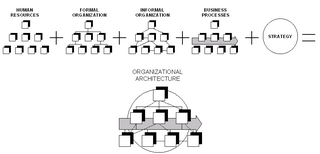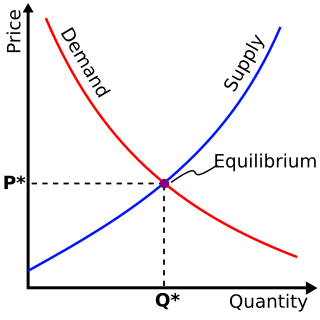Organizational hologram is the method of organization theories described in the book The Organizational Hologram: The Effective Management of Organizational Change (1991), by Kenneth D. Mackenzie.
The method claims that if an organization had twelve holonomic processes working, it would have the property of achieving and maintaining dynamic congruency and would be simultaneously efficient and adaptable.
Holonomic theory states that an organization has 12 management processes (HPs) that drive performance on six desired organizational characteristics (DOCs).
Strategy is a general plan to achieve one or more long-term or overall goals under conditions of uncertainty. In the sense of the "art of the general", which included several subsets of skills including military tactics, siegecraft, logistics etc., the term came into use in the 6th century C.E. in Eastern Roman terminology, and was translated into Western vernacular languages only in the 18th century. From then until the 20th century, the word "strategy" came to denote "a comprehensive way to try to pursue political ends, including the threat or actual use of force, in a dialectic of wills" in a military conflict, in which both adversaries interact.
Organization development (OD) is the study and implementation of practices, systems, and techniques that affect organizational change. The goal of which is to modify a group's/organization's performance and/or culture. The organizational changes are typically initiated by the group's stakeholders. OD emerged from human relations studies in the 1930s, during which psychologists realized that organizational structures and processes influence worker behavior and motivation.
Communications management is the systematic planning, implementing, monitoring, and revision of all the channels of communication within an organization and between organizations. It also includes the organization and dissemination of new communication directives connected with an organization, network, or communications technology. Aspects of communications management include developing corporate communication strategies, designing internal and external communications directives, and managing the flow of information, including online communication. It is a process that helps an organization to be systematic as one within the bounds of communication.
In science and engineering, root cause analysis (RCA) is a method of problem solving used for identifying the root causes of faults or problems. It is widely used in IT operations, manufacturing, telecommunications, industrial process control, accident analysis (e.g., in aviation, rail transport, or nuclear plants), medical diagnosis, the healthcare industry (e.g., for epidemiology), etc. Root cause analysis is a form of inductive inference (first create a theory, or root, based on empirical evidence, or causes) and deductive inference (test the theory, i.e., the underlying causal mechanisms, with empirical data).
Holonomic brain theory is a branch of neuroscience investigating the idea that consciousness is formed by quantum effects in or between brain cells. Holonomic refers to representations in a Hilbert phase space defined by both spectral and space-time coordinates. Holonomic brain theory is opposed by traditional neuroscience, which investigates the brain's behavior by looking at patterns of neurons and the surrounding chemistry.
In social work, a caseworker is not a social worker but is employed by a government agency, nonprofit organization, or another group to take on the cases of individuals and provide them with advocacy, information and solutions. Also, in political arenas, caseworkers are employed as a type of legislative staffer by legislators to provide service to their constituents such as dealing with individual or family concerns. A social worker who works as a caseworker obtains social casework education and training naturally through their compulsory degree works. In social work, casework means to engage a client in learning their situation, to build a suitable plan of action, and helping the client to solve their problems through client commitment and use of their own and community resources, the coordinated service is called case management. British MPs and members of the United States Congress often provide constituent services through caseworkers for better use of their allotted funds.

Organizational architecture, also known as organizational design, is a field concerned with the creation of roles, processes, and formal reporting relationships in an organization. It refers to architecture metaphorically, as a structure which fleshes out the organizations. The various features of a business's organizational architecture has to be internally consistent in strategy, architecture and competitive environment.
Project portfolio management (PPM) is the centralized management of the processes, methods, and technologies used by project managers and project management offices (PMOs) to analyze and collectively manage current or proposed projects based on numerous key characteristics. The objectives of PPM are to determine the optimal resource mix for delivery and to schedule activities to best achieve an organization's operational and financial goals, while honouring constraints imposed by customers, strategic objectives, or external real-world factors. Standards for Portfolio Management include Project Management Institute's framework for project portfolio management, Management of Portfolios by Office of Government Commerce and the PfM² Portfolio Management Methodology by the PM² Foundation.
Competence is the set of demonstrable personal characteristics or KSAOs that enable job performance at a high level with consistency and minimal difficulty. Competency in human resources is an organizational criterion for excellence that encompasses the behaviors, experience, knowledge, skills, and abilities that enable employees to perform their roles effectively and reliably.

Workforce productivity is the amount of goods and services that a group of workers produce in a given amount of time. It is one of several types of productivity that economists measure. Workforce productivity, often referred to as labor productivity, is a measure for an organisation or company, a process, an industry, or a country.
Internal auditing is an independent, objective assurance and consulting activity designed to add value and improve an organization's operations. It helps an organization accomplish its objectives by bringing a systematic, disciplined approach to evaluate and improve the effectiveness of risk management, control and governance processes. Internal auditing might achieve this goal by providing insight and recommendations based on analyses and assessments of data and business processes. With commitment to integrity and accountability, internal auditing provides value to governing bodies and senior management as an objective source of independent advice. Professionals called internal auditors are employed by organizations to perform the internal auditing activity.
The following outline is provided as an overview of and topical guide to business management:
Control is a function of management that helps to check errors and take corrective actions. This is done to minimize deviation from standards and ensure that the stated goals of the organization are achieved in a desired manner.
Design science research (DSR) is a research paradigm focusing on the development and validation of prescriptive knowledge in information science. Herbert Simon distinguished the natural sciences, concerned with explaining how things are, from design sciences which are concerned with how things ought to be, that is, with devising artifacts to attain goals. Design science research methodology (DSRM) refers to the research methodologies associated with this paradigm. It spans the methodologies of several research disciplines, for example information technology, which offers specific guidelines for evaluation and iteration within research projects.
Change management (CM) is a discipline that focuses on managing changes within an organization. Change management involves implementing approaches to prepare and support individuals, teams, and leaders in making organizational change. Change management is useful when organizations are considering major changes such as restructure, redirecting or redefining resources, updating or refining business process and systems, or introducing or updating digital technology.
In organizational development, corporate diagnostics provides tools for the effective diagnosis of organizational culture, and structural and operational strengths and weaknesses.

A working group is a group of experts working together to achieve specified goals. Such groups are domain-specific and focus on discussion or activity around a specific subject area. The term can sometimes refer to an interdisciplinary collaboration of researchers, often from more than one organization, working on new activities that would be difficult to sustain under traditional funding mechanisms. Working groups are variously also called task groups, workgroups, technical advisory groups, working parties, or task forces.

Knowledge-Based Decision-Making (KBDM) in management is a decision-making process that uses predetermined criteria to measure and ensure the optimal outcome for a specific topic.

Team effectiveness is the capacity a team has to accomplish the goals or objectives administered by an authorized personnel or the organization. A team is a collection of individuals who are interdependent in their tasks, share responsibility for outcomes, and view themselves as a unit embedded in an institutional or organizational system which operates within the established boundaries of that system. Teams and groups have established a synonymous relationship within the confines of processes and research relating to their effectiveness while still maintaining their independence as two separate units, as groups and their members are independent of each other's role, skill, knowledge or purpose versus teams and their members, who are interdependent upon each other's role, skill, knowledge and purpose.
Design culture is an organizational culture focused on approaches that improve customer experiences through design. In every firm, the design culture is of significance as it allows the company to understand users and their needs. Integration of design culture in any organization aims at creating experiences that add value to their respective users. In general, design culture entails undertaking design as the forefront of every operation in the organization, from strategy formulation to execution. Every organization is responsible for ensuring a healthy design culture through the application of numerous strategies. For instance, an organization should provide a platform that allows every stakeholder to engage in design recesses. Consequently, employees across the board need to incorporate design thinking, which is associated with innovation and critical thinking.